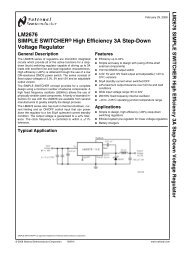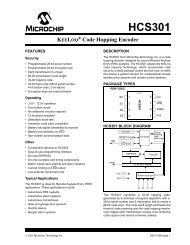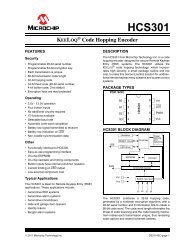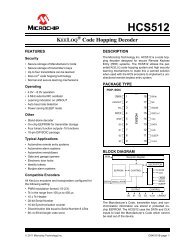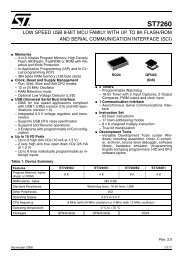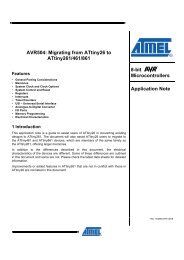dsPIC30F2010 Data Sheet - Microchip
dsPIC30F2010 Data Sheet - Microchip
dsPIC30F2010 Data Sheet - Microchip
You also want an ePaper? Increase the reach of your titles
YUMPU automatically turns print PDFs into web optimized ePapers that Google loves.
<strong>dsPIC30F2010</strong><br />
6.6.3 LOADING WRITE LATCHES<br />
Example 6-2 shows a sequence of instructions that<br />
can be used to load the 96 bytes of write latches. 32<br />
TBLWTL and 32 TBLWTH instructions are needed to<br />
load the write latches selected by the table pointer.<br />
EXAMPLE 6-2:<br />
LOADING WRITE LATCHES<br />
; Set up a pointer to the first program memory location to be written<br />
; program memory selected, and writes enabled<br />
MOV #0x0000,W0 ;<br />
MOV W0 , TBLPAG ; Initialize PM Page Boundary SFR<br />
MOV #0x6000,W0 ; An example program memory address<br />
; Perform the TBLWT instructions to write the latches<br />
; 0th_program_word<br />
MOV #LOW_WORD_0,W2 ;<br />
MOV #HIGH_BYTE_0,W3 ;<br />
TBLWTL W2 , [W0] ; Write PM low word into program latch<br />
TBLWTH W3 , [W0++] ; Write PM high byte into program latch<br />
; 1st_program_word<br />
MOV #LOW_WORD_1,W2 ;<br />
MOV #HIGH_BYTE_1,W3 ;<br />
TBLWTL W2 , [W0] ; Write PM low word into program latch<br />
TBLWTH W3 , [W0++] ; Write PM high byte into program latch<br />
; 2nd_program_word<br />
MOV #LOW_WORD_2,W2 ;<br />
MOV #HIGH_BYTE_2,W3 ;<br />
TBLWTL W2 , [W0] ; Write PM low word into program latch<br />
TBLWTH W3 , [W0++] ; Write PM high byte into program latch<br />
•<br />
•<br />
•<br />
; 31st_program_word<br />
MOV #LOW_WORD_31,W2 ;<br />
MOV #HIGH_BYTE_31,W3 ;<br />
TBLWTL W2 , [W0] ; Write PM low word into program latch<br />
TBLWTH W3 , [W0++] ; Write PM high byte into program latch<br />
Note: In Example 6-2, the contents of the upper byte of W3 has no effect.<br />
6.6.4 INITIATING THE PROGRAMMING<br />
SEQUENCE<br />
For protection, the write initiate sequence for NVMKEY<br />
must be used to allow any erase or program operation<br />
to proceed. After the programming command has been<br />
executed, the user must wait for the programming time<br />
until programming is complete. The two instructions<br />
following the start of the programming sequence<br />
should be NOPs.<br />
EXAMPLE 6-3:<br />
INITIATING A PROGRAMMING SEQUENCE<br />
DISI #5 ; Block all interrupts with priority





